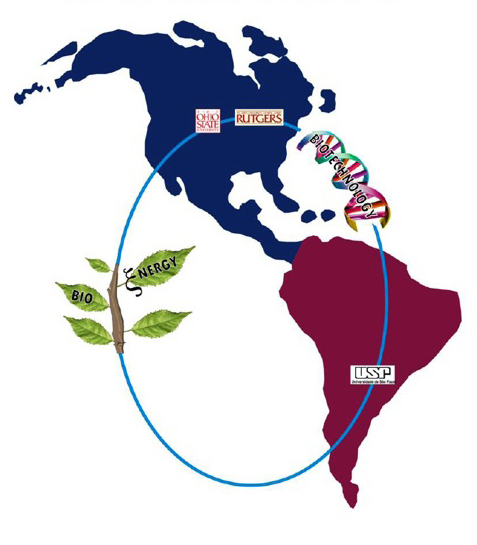The two schools have longstanding partnerships with Brazilian researchers; current focus to harness energy from agricultural crops
Rutgers’ joining the Big Ten is prompting plant biotechnologists at Rutgers and Ohio State to pursue new ways to work together on harnessing energy from agricultural crops, a renewable resource that could help our country in its quest for energy independence and environmental sustainability.

Yet the roots of this nascent collaboration stretch back more than two decades, long before anyone foresaw an athletic partnership between the Eastern and Midwestern schools.
Both universities had established their own research and teaching partnerships with the University of São Paulo in Brazil – Ohio State’s beginning in the 1980s, and Rutgers’ in 1993. These partnerships thrived on complementary skills, such as Rutgers’ and Ohio State’s strengths in plant genome research and São Paulo’s strengths in citrus and sugar cane agriculture. One result from the partners’ research resulted in citrus plants with better disease resistance.
In 1997, all three universities gathered together in Brazil for the first time to discuss research results and student exchange programs resulting from the two partnerships. While these so-called “tripartite” conferences have continued to take place every two years, the formal partnerships still remained with their original parties: Ohio State and São Paulo, and Rutgers and São Paulo.
“The Ohio State and Rutgers researchers have been in close contact for 16 years now,” said Eric Lam, distinguished professor of plant biology and pathology in the School of Environmental and Biological Sciences. “Now is a good time, with our transition into the Big Ten, to leverage each other’s research in the broad biotechnology field.”
While Lam cites the Big Ten partnership as one reason to step up collaboration with Ohio State now, there are others. The two schools have complementary genetic expertise, he says – Ohio State’s in crops such as corn and soybeans and Rutgers’ in turf grass, cranberries and blueberries.
And the new focus on energy-producing crops is already being tackled by each partnership. Both are examining ways to genetically enhance sugar cane – a crop that supplies much of Brazil’s motor vehicle fuel – to grow in more areas of the U.S. than limited coastal regions of Florida and Louisiana. Brazil’s expertise in producing ethanol from sugar cane – essentially an "energy" grass – could help the American universities enhance native North American plants, such as switch grass, into economical energy sources.
“Previously, we may have seen each other more as competitors,” said Lam, acknowledging the reality of how research groups chase limited grant funding. “But now that we’re in the same family and have established mutual interests with Brazil, we have common ground to team up on research proposals.”
Lam, who is organizing the next tripartite conference to be hosted by Rutgers this fall, credits Rod Sharp, an Ohio State professor of microbiology from 1969 to 1979 and later the dean of research in what was then Cook College at Rutgers, for promoting and establishing both universities’ partnerships with São Paulo.
“Since 1971, I’ve had a relationship with São Paulo, and that relationship never stopped,” Sharp said. During a trip to São Paulo in 1993, shortly after he joined Rutgers, Sharp pitched collaboration opportunities with Rutgers to colleagues at Brazil. And when he returned, he told his Rutgers colleagues how impressed he was with the faculty and students at São Paulo. Two years later, faculty from each school visited the other and Sharp inked a partnership agreement with Raul Machado, now vice president of international programs at the University of São Paulo.
“Now with Rutgers joining the Big Ten and the CIC (the Committee on Institutional Cooperation, an academic consortium of Big Ten member universities), there’s a huge opportunity for more collaboration with Ohio State,” said Sharp, who remains active as an adviser to Ohio State. “Rutgers and Ohio State could be incredible allies.”